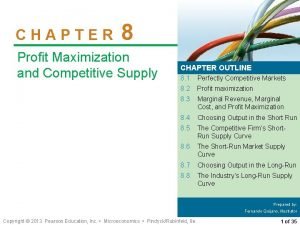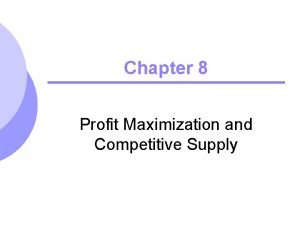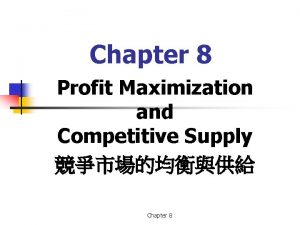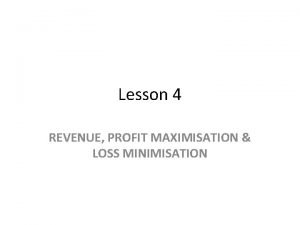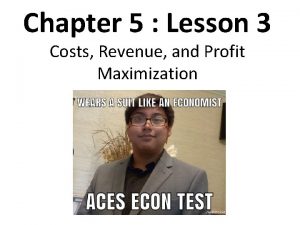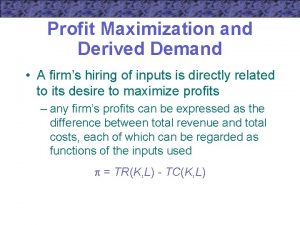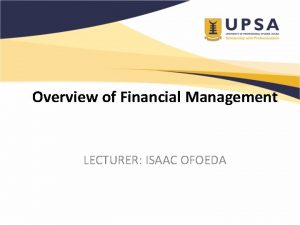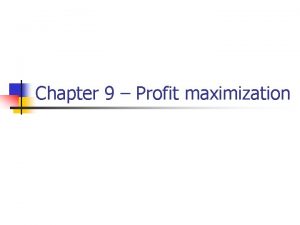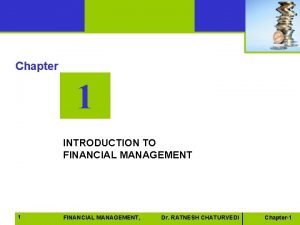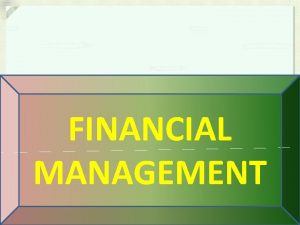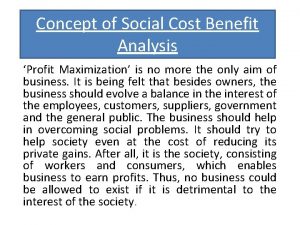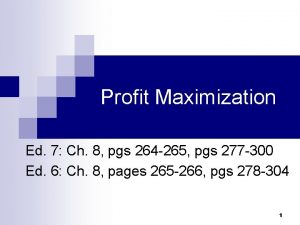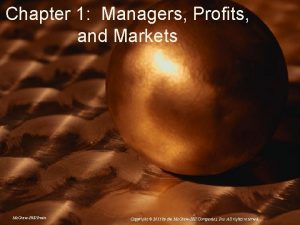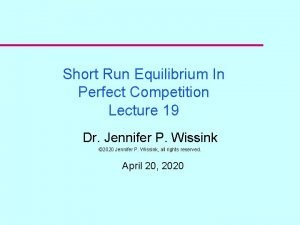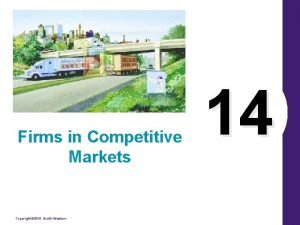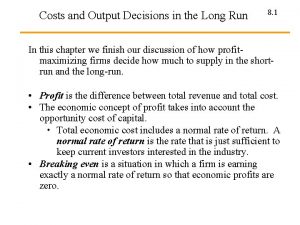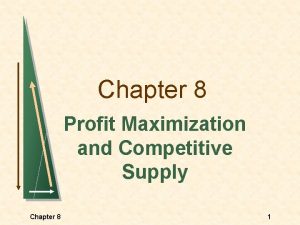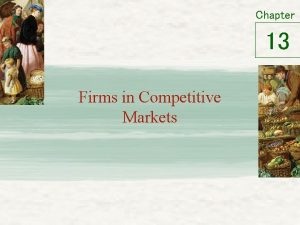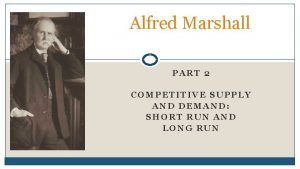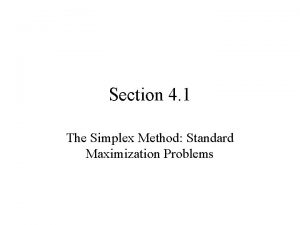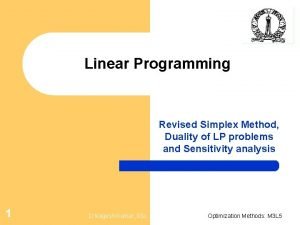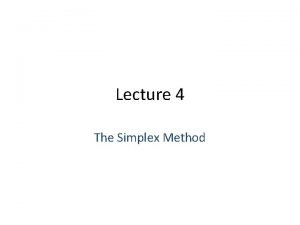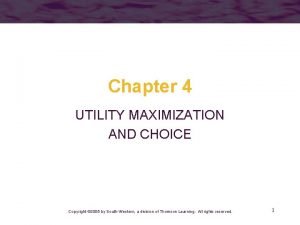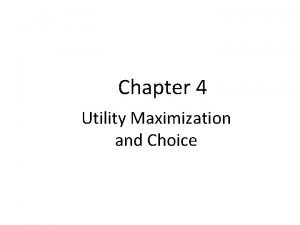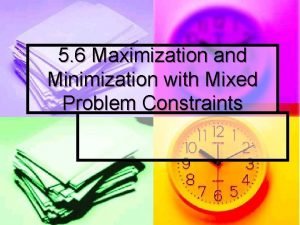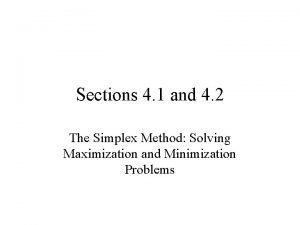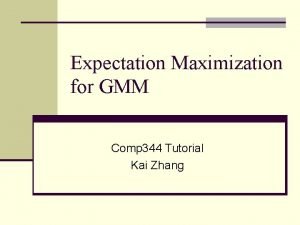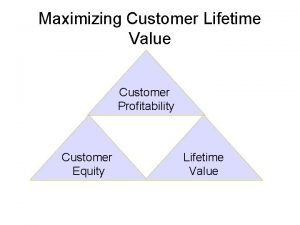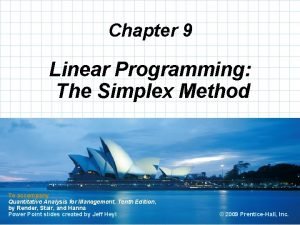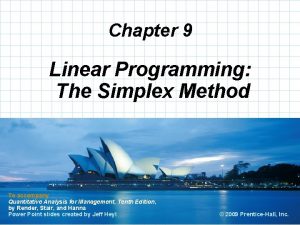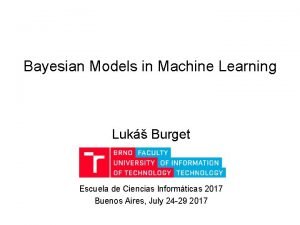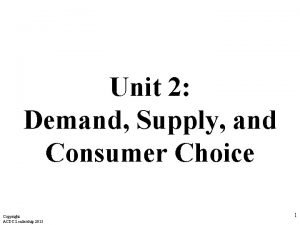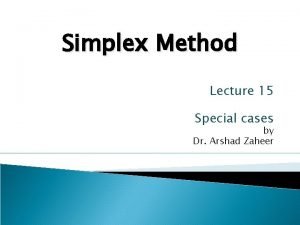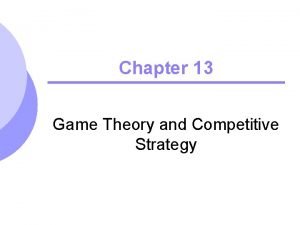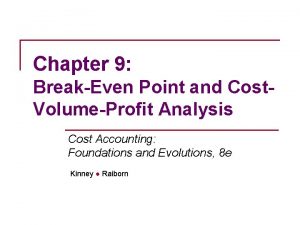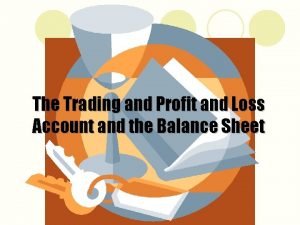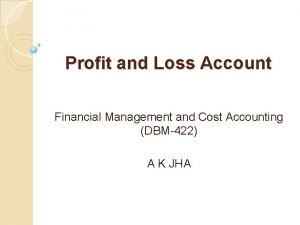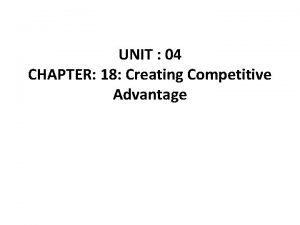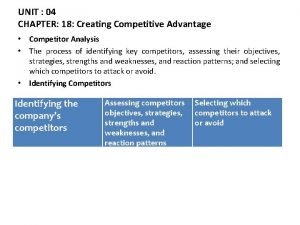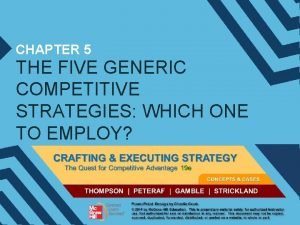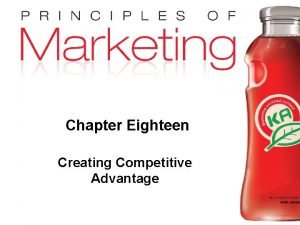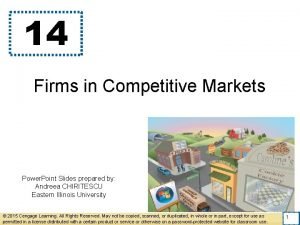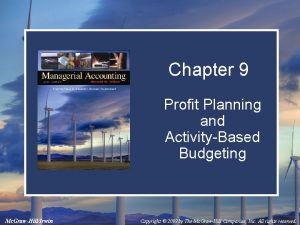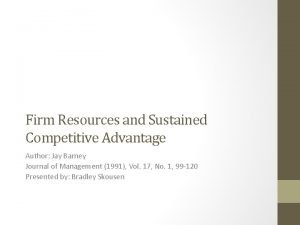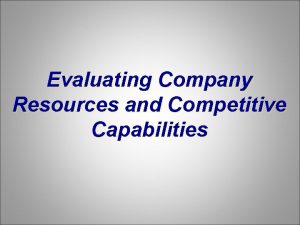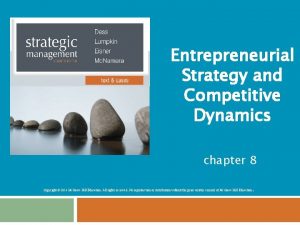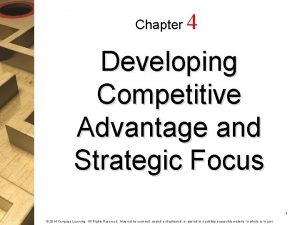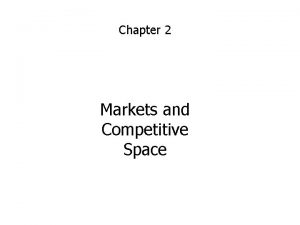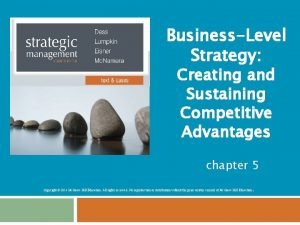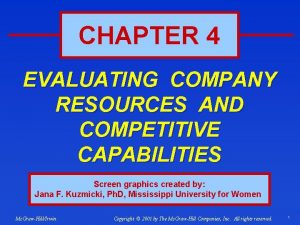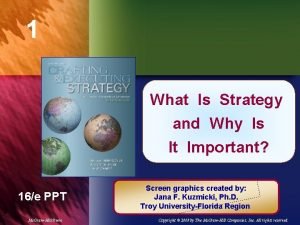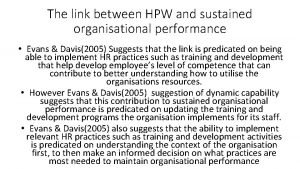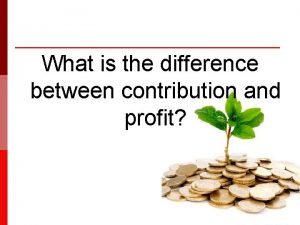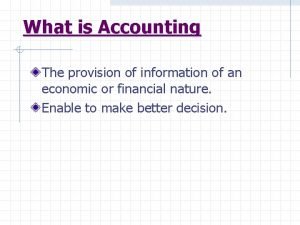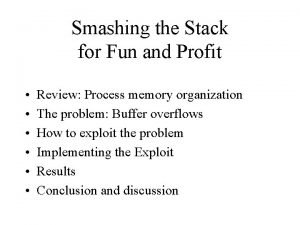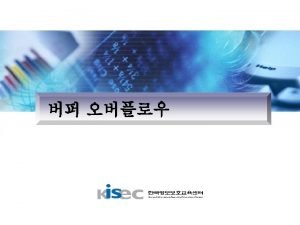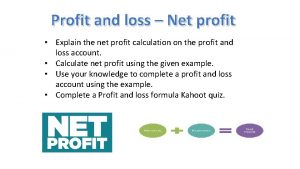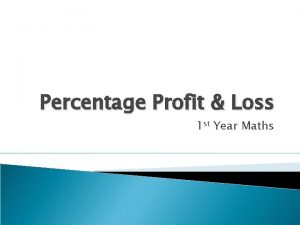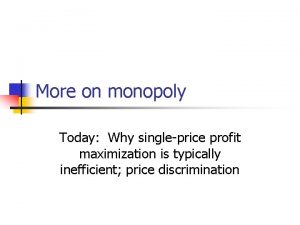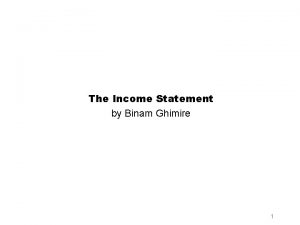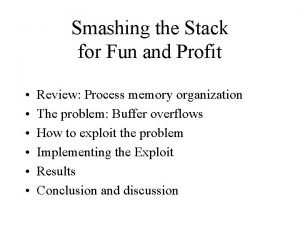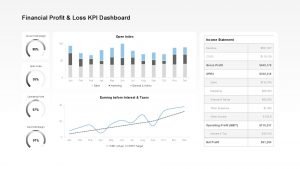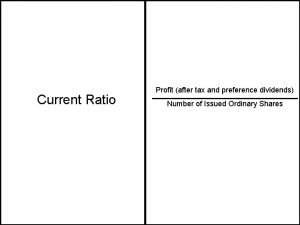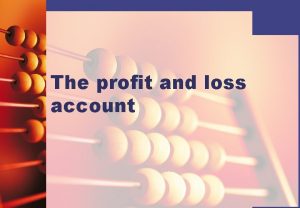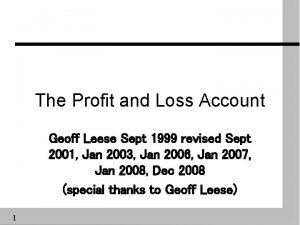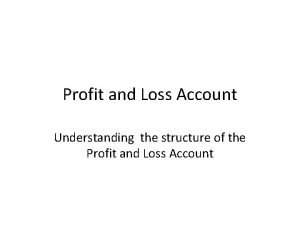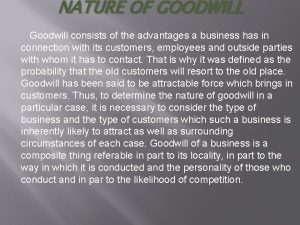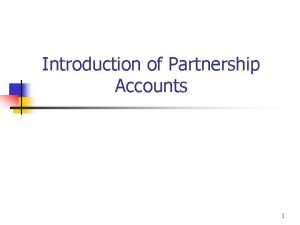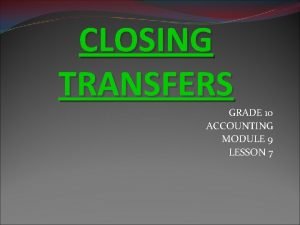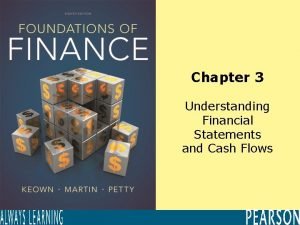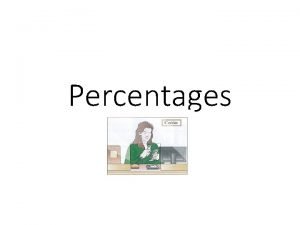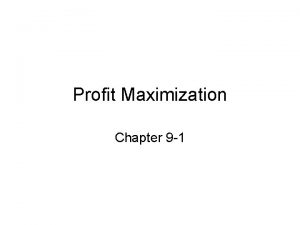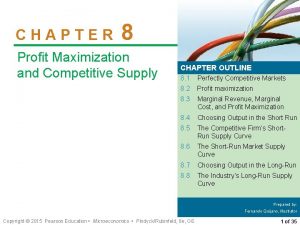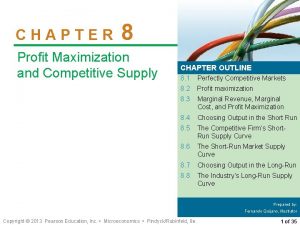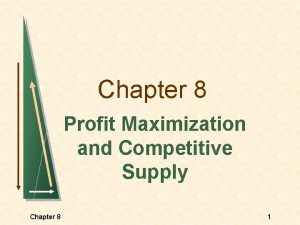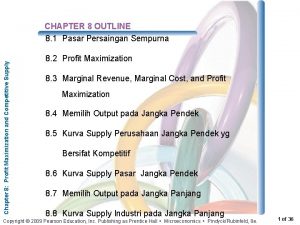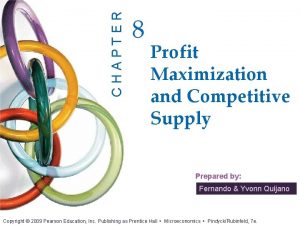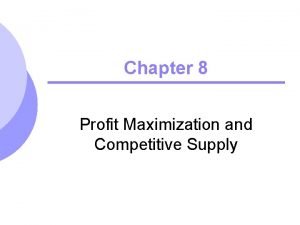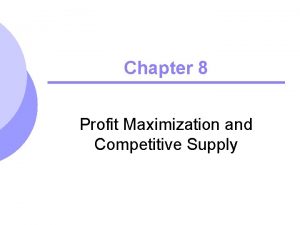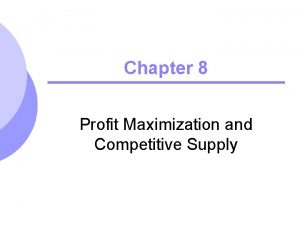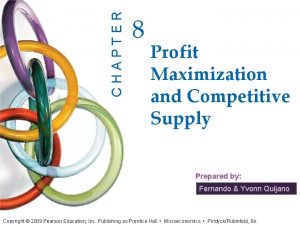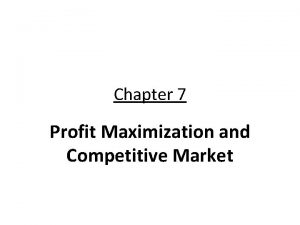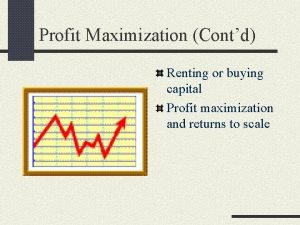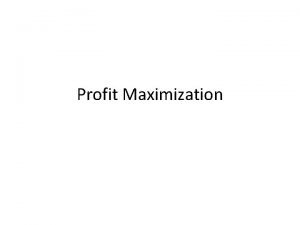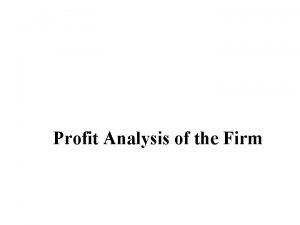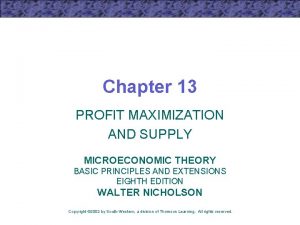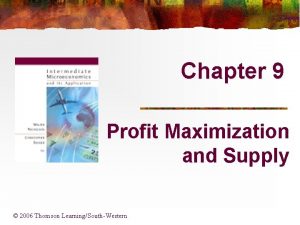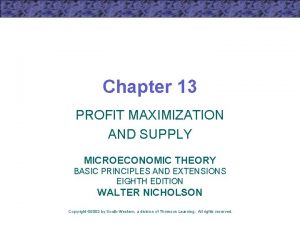Chapter 8 Profit Maximization and Competitive Supply Chapter

























































































- Slides: 89

Chapter 8 Profit Maximization and Competitive Supply Chapter 8 1

Topics to be Discussed n Perfectly Competitive Markets n Profit Maximization n Marginal Revenue, Marginal Cost, and Profit Maximization n Choosing Output in the Short-Run Chapter 8 2

Topics to be Discussed n The Competitive Firm’s Short-Run Supply Curve n Short-Run Market Supply n Choosing Output in the Long-Run n The Industry’s Long-Run Supply Curve Chapter 8 3

Perfectly Competitive Markets n Characteristics of Perfectly Competitive Markets 1) Price taking 2) Product homogeneity 3) Free entry and exit Chapter 8 4

Perfectly Competitive Markets n Price Taking l The individual firm sells a very small share of the total market output and, therefore, cannot influence market price. l The individual consumer buys too small a share of industry output to have any impact on market price. Chapter 8 5

Perfectly Competitive Markets n Product Homogeneity l The products of all firms are perfect substitutes. l Examples u Chapter 8 Agricultural products, oil, copper, iron, lumber 6

Perfectly Competitive Markets n Free Entry and Exit l Buyers can easily switch from one supplier to another. l Suppliers Chapter 8 can easily enter or exit a market. 7

Perfectly Competitive Markets n Discussion Questions l What l Are are some barriers to entry and exit? all markets competitive? l When Chapter 8 is a market highly competitive? 8

Profit Maximization n Do firms maximize profits? l Possibility Chapter 8 of other objectives u Revenue maximization u Dividend maximization u Short-run profit maximization 9

Profit Maximization n Do firms maximize profits? l Implications u u Chapter 8 of non-profit objective Over the long-run investors would not support the company Without profits, survival unlikely 10

Profit Maximization n Do firms maximize profits? l Long-run profit maximization is valid and does not exclude the possibility of altruistic behavior. Chapter 8 11

Marginal Revenue, Marginal Cost, and Profit Maximization n Determining the profit maximizing level of output l Profit ( l Total Revenue (R) = Pq l Total Cost (C) = Cq l Therefore: Chapter 8 ) = Total Revenue - Total Cost 12

Profit Maximization in the Short Run Total Revenue Cost, Revenue, Profit ($s per year) R(q) Slope of R(q) = MR 0 Output (units per year) Chapter 8 13

Profit Maximization in the Short Run C(q) Cost, Revenue, Profit $ (per year) Total Cost Slope of C(q) = MC Why is cost positive when q is zero? 0 Output (units per year) Chapter 8 14

Marginal Revenue, Marginal Cost, and Profit Maximization n Marginal revenue is the additional revenue from producing one more unit of output. n Marginal cost is the additional cost from producing one more unit of output. Chapter 8 15

Marginal Revenue, Marginal Cost, and Profit Maximization n Comparing R(q) and C(q) l Output levels: 0 - q 0: u C(q)> R(q) l C(q) FC + VC > R(q) u MR > MC Indicates higher profit at higher output R(q) A Negative profit u l Cost, Revenue, Profit ($s per year) B 0 q* Output (units per year) Chapter 8 16

Marginal Revenue, Marginal Cost, and Profit Maximization n Comparing R(q) and C(q) l Question: Why is profit negative when output is zero? Cost, Revenue, Profit $ (per year) C(q) R(q) A B 0 q* Output (units per year) Chapter 8 17

Marginal Revenue, Marginal Cost, and Profit Maximization n Comparing R(q) and C(q) l Output levels: q 0 - q* u R(q)> C(q) u MR > MC l l Cost, Revenue, Profit $ (per year) C(q) R(q) A Indicates higher profit at higher output Profit is increasing B 0 q* Output (units per year) Chapter 8 18

Marginal Revenue, Marginal Cost, and Profit Maximization n Comparing R(q) and C(q) l Output level: q* u R(q)= C(q) u MR = MC u Profit is maximized Cost, Revenue, Profit $ (per year) C(q) R(q) A B 0 q* Output (units per year) Chapter 8 19

Marginal Revenue, Marginal Cost, and Profit Maximization n Question l Why is profit reduced when producing more or less than q*? Cost, Revenue, Profit $ (per year) C(q) R(q) A B 0 q* Output (units per year) Chapter 8 20

Marginal Revenue, Marginal Cost, and Profit Maximization n Comparing R(q) and C(q) l Output levels beyond q*: u R(q)> C(q) u MC > MR u Cost, Revenue, Profit $ (per year) C(q) R(q) A Profit is decreasing B 0 q* Output (units per year) Chapter 8 21

Marginal Revenue, Marginal Cost, and Profit Maximization n Therefore, it can be said: l Profits are maximized when MC = MR. Cost, Revenue, Profit $ (per year) C(q) R(q) A B 0 q* Output (units per year) Chapter 8 22

Marginal Revenue, Marginal Cost, and Profit Maximization Chapter 8 23

Marginal Revenue, Marginal Cost, and Profit Maximization Chapter 8 24

Marginal Revenue, Marginal Cost, and Profit Maximization n The Competitive Firm l Price taker l Market output (Q) and firm output (q) l Market demand (D) and firm demand (d) l R(q) Chapter 8 is a straight line 25

Demand Marginal Revenue Faced by a Competitive Firm Price $ per bushel Firm $4 d Industry $4 D 100 Chapter 8 200 Output (bushels) 100 Output (millions of bushels) 26

Marginal Revenue, Marginal Cost, and Profit Maximization n The Competitive Firm l The u u Chapter 8 competitive firm’s demand Individual producer sells all units for $4 regardless of the producer’s level of output. If the producer tries to raise price, sales are zero. 27

Marginal Revenue, Marginal Cost, and Profit Maximization n The Competitive Firm l The u u Chapter 8 competitive firm’s demand If the producers tries to lower price he cannot increase sales P = D = MR = AR 28

Marginal Revenue, Marginal Cost, and Profit Maximization n The Competitive Firm l Profit u Chapter 8 Maximization MC(q) = MR = P 29

Choosing Output in the Short Run n We will combine production and cost analysis with demand to determine output and profitability. Chapter 8 30

A Competitive Firm Making a Positive Profit MC Price 60 ($ per unit) 50 40 Lost profit for qq < q * A D Lost profit for q 2 > q * ATC C B 30 AVC At q*: MR = MC and P > ATC q 1 : MR > MC and q 2: MC > MR 20 and q 0: MC = MR but MC falling 10 0 Chapter 8 AR=MR=P 1 q 0 2 3 4 5 6 7 q 1 8 q* 9 q 2 10 11 Output 31

A Competitive Firm Incurring Losses MC Price ($ per unit) C D At q*: MR = MC and P < ATC Losses = P- AC) x q* or ABCD F B A P = MR AVC E q* Chapter 8 ATC Would this producer continue to produce with a loss? Output 32

Choosing Output in the Short Run n Summary of Production Decisions l Profit l If is maximized when MC = MR P > ATC the firm is making profits. l If AVC < P < ATC the firm should produce at a loss. l If P < AVC < ATC the firm should shutdown. Chapter 8 33

The Short-Run Output of an Aluminum Smelting Plant Cost (dollars per item) 1400 Observations • Price between $1140 & $1300: q = 600 • Price > $1300: q = 900 • Price < $1140: q = 0 P 2 1300 P 1 1200 Question Should the firm stay in business when P < $1140? 1140 1100 0 Chapter 8 300 600 900 Output (tons per day) 34

Some Cost Considerations for Managers n Three guidelines for estimating marginal cost: 1) Average variable cost should not be used as a substitute for marginal cost. Chapter 8 35

Some Cost Considerations for Managers n Three guidelines for estimating marginal cost: 2) A single item on a firm’s accounting ledger may have two components, only one of which involves marginal cost. Chapter 8 36

Some Cost Considerations for Managers n Three guidelines for estimating marginal cost: 3) All opportunity cost should be included in determining marginal cost. Chapter 8 37

A Competitive Firm’s Short-Run Supply Curve Price ($ per unit) The firm chooses the output level where MR = MC, as long as the firm is able to cover its variable cost of production. MC P 2 ATC P 1 AVC What happens if P < AVC? P = AVC q 1 Chapter 8 q 2 Output 38

A Competitive Firm’s Short-Run Supply Curve n n Observations: l P = MR l MR = MC l P = MC Supply is the amount of output for every possible price. Therefore: l If P = P 1, then q = q 1 l If P = P 2, then q = q 2 Chapter 8 39

A Competitive Firm’s Short-Run Supply Curve Price ($ per unit) S = MC above AVC MC P 2 ATC P 1 AVC P = AVC Shut-down q 1 Chapter 8 q 2 Output 40

A Competitive Firm’s Short-Run Supply Curve n Observations: l Supply is upward sloping due to diminishing returns. l Higher price compensates the firm for higher cost of additional output and increases total profit because it applies to all units. Chapter 8 41

A Competitive Firm’s Short-Run Supply Curve n Firm’s Response to an Input Price Change l Chapter 8 When the price of a firm’s product changes, the firm changes its output level, so that the marginal cost of production remains equal to the price. 42

The Response of a Firm to a Change in Input Price ($ per unit) MC 2 Savings to the firm from reducing output Input cost increases and MC shifts to MC 2 and q falls to q 2. MC 1 $5 q 2 Chapter 8 q 1 Output 43

The Short-Run Production of Petroleum Products Cost ($ per barrel) 27 The MC of producing a mix of petroleum products from crude oil increases sharply at several levels of output as the refinery shifts from one processing unit to another. 26 SMC How much would be produced if P = $23? P = $24 -$25? 25 24 23 8, 000 Chapter 8 9, 000 10, 000 11, 000 Output (barrels/day) 44

The Short-Run Production of Petroleum Products n Stepped SMC indicates a different production (cost) process at various capacity levels. n Observation: l Chapter 8 With a stepped MC function, small changes in price may not trigger a change in output. 45

The Short-Run Production of Petroleum Products n The short-run market supply curve shows the amount of output that the industry will produce in the short-run for every possible price. n Consider, for simplicity, a competitive market with three firms: Chapter 8 46

Industry Supply in the Short Run MC 1 MC 2 $ per unit MC 3 S The short-run industry supply curve is the horizontal summation of the supply curves of the firms. P 3 P 2 P 1 0 Chapter 8 Question: If increasing output raises input costs, what impact would it have on market supply? 2 4 5 7 8 10 15 Quantity 21 47

The Short-Run Market Supply Curve n Elasticity of Market Supply Chapter 8 48

The Short-Run Market Supply Curve n Perfectly inelastic short-run supply arises when the industry’s plant and equipment are so fully utilized that new plants must be built to achieve greater output. n Perfectly elastic short-run supply arises when marginal costs are constant. Chapter 8 49

The Short-Run Market Supply Curve n Producer Surplus in the Short Run l Firms earn a surplus on all but the last unit of output. l The producer surplus is the sum over all units produced of the difference between the market price of the good and the marginal cost of production. Chapter 8 50

Producer Surplus for a Firm Price ($ per unit of output) At q* MC = MR. Between 0 and q , MR > MC for all units. Producer Surplus MC AVC B A D 0 Chapter 8 P C q* Alternatively, VC is the sum of MC or ODCq*. R is P x q* or OABq*. Producer surplus = R - VC or ABCD. Output 51

The Short-Run Market Supply Curve n Producer Surplus in the Short-Run Chapter 8 52

The Short-Run Market Supply Curve n Observation l Short-run Chapter 8 with positive fixed cost 53

Producer Surplus for a Market Price ($ per unit of output) S Market producer surplus is the difference between P* and S from 0 to Q*. P* Producer Surplus D Q* Chapter 8 Output 54

Choosing Output in the Long Run n In the long run, a firm can alter all its inputs, including the size of the plant. n We assume free entry and free exit. Chapter 8 55

Output Choice in the Long Run Price ($ per unit of output) In the long run, the plant size will be increased and output increased to q 3. Long-run profit, EFGD > short run profit ABCD. LMC LAC SMC D $40 SAC A C G E B P = MR F $30 In the short run, the firm is faced with fixed inputs. P = $40 > ATC. Profit is equal to ABCD. q 1 Chapter 8 q 2 q 3 Output 56

Output Choice in the Long Run Price ($ per unit of output) Question: Is the producer making a profit after increased output lowers the price to $30? LMC LAC SMC D $40 SAC A C G E B P = MR F $30 q 1 Chapter 8 q 2 q 3 Output 57

Choosing Output in the Long Run n Accounting Profit & Economic Profit l Accounting profit l Economic profit uwl = R = w. L - r. K = labor cost urk = Chapter 8 = R - w. L opportunity cost of capital 58

Choosing Output in the Long Run Long-Run Competitive Equilibrium n Zero-Profit l If R > w. L + rk, economic profits are positive l If R = w. L + rk, zero economic profits, but the firms is earning a normal rate of return; indicating the industry is competitive l If R < wl + rk, consider going out of business Chapter 8 59

Choosing Output in the Long Run Long-Run Competitive Equilibrium n Entry and Exit l The long-run response to short-run profits is to increase output and profits. l Profits will attract other producers. l More producers increase industry supply which lowers the market price. Chapter 8 60

Long-Run Competitive Equilibrium • Profit attracts firms • Supply increases until profit = 0 $ per unit of output Firm Industry S 1 LMC $40 LAC $30 P 1 S 2 P 2 D q 2 Chapter 8 Output Q 1 Q 2 Output 61

Choosing Output in the Long Run n Long-Run Competitive Equilibrium 1) MC = MR 2) P = LAC u No incentive to leave or enter u Profit = 0 3) Equilibrium Market Price Chapter 8 62

Choosing Output in the Long Run n Questions 1) Explain the market adjustment when P < LAC and firms have identical costs. 2) Explain the market adjustment when firms have different costs. 3) What is the opportunity cost of land? Chapter 8 63

Choosing Output in the Long Run n Economic Rent l Economic rent is the difference between what firms are willing to pay for an input less the minimum amount necessary to obtain it. Chapter 8 64

Firms Earn Zero Profit in Long-Run Equilibrium Ticket Price LMC LAC A baseball team in a moderate-sized city sells enough tickets so that price is equal to marginal and average cost (profit = 0). $7 1. 0 Chapter 8 Season Tickets Sales (millions) 65

Firms Earn Zero Profit in Long-Run Equilibrium Ticket Price Economic Rent LMC LAC $10 $7 A team with the same cost in a larger city sells tickets for $10. 1. 3 Chapter 8 Season Tickets Sales (millions) 66

Firms Earn Zero Profit in Long-Run Equilibrium n With a fixed input such as a unique location, the difference between the cost of production (LAC = 7) and price ($10) is the value or opportunity cost of the input (location) and represents the economic rent from the input. Chapter 8 67

Firms Earn Zero Profit in Long-Run Equilibrium n If the opportunity cost of the input (rent) is not taken into consideration it may appear that economic profits exist in the long-run. Chapter 8 68

The Industry’s Long-Run Supply Curve n The shape of the long-run supply curve depends on the extent to which changes in industry output affect the prices the firms must pay for inputs. Chapter 8 69

The Industry’s Long-Run Supply Curve n To determine long-run supply, we assume: l All firms have access to the available production technology. l Output is increased by using more inputs, not by invention. Chapter 8 70

The Industry’s Long-Run Supply Curve n To determine long-run supply, we assume: l The market for inputs does not change with expansions and contractions of the industry. Chapter 8 71

Long-Run Supply in a Constant-Cost Industry $ per unit of output Economic profits attract new firms. Supply increases to S 2 and the market returns to long-run equilibrium. MC AC $ per unit of output P 2 Q 1 increase to Q 2. Long-run supply = SL = LRAC. Change in output has no impact on input cost. S 1 S 2 C P 2 A P 1 B SL P 1 D 1 q 2 Chapter 8 Output Q 1 Q 2 D 2 Output 72

Long-Run Supply in a Constant-Cost Industry n In a constant-cost industry, long-run supply is a horizontal line at a price that is equal to the minimum average cost of production. Chapter 8 73

Long-Run Supply in an Increasing-Cost Industry $ per unit of output SMC 2 SMC 1 LAC 2 LAC 1 P 2 $ per unit of output Due to the increase in input prices, long-run equilibrium occurs at a higher price. S 1 S 2 P 3 P 1 P 1 B A D 1 q 1 Chapter 8 q 2 Output SL Q 1 Q 2 Q 3 D 1 Output 74

Long-Run Supply in a Increasing-Cost Industry n In a increasing-cost industry, long-run supply curve is upward sloping. Chapter 8 75

The Industry’s Long-Run Supply Curve n Questions 1) Explain how decreasing-cost is possible. 2) Illustrate a decreasing cost industry. 3) What is the slope of the SL in a decreasing-cost industry? Chapter 8 76

Long-Run Supply in an Decreasing-Cost Industry $ per unit of output Due to the decrease in input prices, long-run equilibrium occurs at a lower price. $ per unit of output SMC 1 S 2 SMC 2 LAC 1 P 2 LAC 2 P 1 P 3 A B SL D 1 q 1 Chapter 8 q 2 Output Q 1 Q 2 Q 3 D 2 Output 77

Long-Run Supply in a Increasing-Cost Industry n In a decreasing-cost industry, long-run supply curve is downward sloping. Chapter 8 78

The Industry’s Long-Run Supply Curve n The Effects of a Tax l In an earlier chapter we studied how firms respond to taxes on an input. l Now, we will consider how a firm responds to a tax on its output. Chapter 8 79

Effect of an Output Tax on a Competitive Firm’s Output Price ($ per unit of output) MC 2 = MC 1 + tax An output tax raises the firm’s marginal cost by the amount of the tax. MC 1 The firm will reduce output to the point at which the marginal cost plus the tax equals the price. t P 1 AVC 2 AVC 1 q 2 Chapter 8 q 1 Output 80

Effect of an Output Tax on Industry Output Price ($ per unit of output) S 2 = S 1 + t S 1 t P 2 Tax shifts S 1 to S 2 and output falls to Q 2. Price increases to P 2. P 1 D Q 2 Chapter 8 Q 1 Output 81

The Industry’s Long-Run Supply Curve n Long-Run Elasticity of Supply 1) Constant-cost industry u. Long-run supply is horizontal u. Small increase in price will induce an extremely large output increase Chapter 8 82

The Industry’s Long-Run Supply Curve n Long-Run Elasticity of Supply 1) Constant-cost industry u u Chapter 8 Long-run supply elasticity is infinitely large Inputs would be readily available 83

The Industry’s Long-Run Supply Curve n Long-Run Elasticity of Supply 2) Increasing-cost industry u u u Chapter 8 Long-run supply is upward-sloping and elasticity is positive The slope (elasticity) will depend on the rate of increase in input cost Long-run elasticity will generally be greater than short-run elasticity of supply 84

Summary n The managers of firms can operate in accordance with a complex set of objectives and under various constraints. n A competitive market makes its output choice under the assumption that the demand for its own output is horizontal. Chapter 8 85

Summary n In the short run, a competitive firm maximizes its profit by choosing an output at which price is equal to (shortrun) marginal cost. n The short-run market supply curve is the horizontal summation of the supply curves of the firms in an industry. Chapter 8 86

Summary n The producer surplus for a firm is the difference between revenue of a firm and the minimum cost that would be necessary to produce the profitmaximizing output. n Economic rent is the payment for a scarce resource of production less the minimum amount necessary to hire that factor. Chapter 8 87

Summary n In the long-run, profit-maximizing competitive firms choose the output at which price is equal to long-run marginal cost. n The long-run supply curve for a firm can be horizontal, upward sloping, or downward sloping. Chapter 8 88

End of Chapter 8 Profit Maximization and Competitive Supply Chapter 8 89
 Profit maximization and competitive supply
Profit maximization and competitive supply Profit maximization and competitive supply
Profit maximization and competitive supply Profit maximization and competitive supply
Profit maximization and competitive supply Profit maximizing output
Profit maximizing output Cost revenue and profit maximization guided reading
Cost revenue and profit maximization guided reading Monopsony profit maximization
Monopsony profit maximization Limitations of profit maximization
Limitations of profit maximization Normal profit economics
Normal profit economics Module 53 featured worksheet profit maximization
Module 53 featured worksheet profit maximization Wealth maximization
Wealth maximization Finance management definition
Finance management definition Abt model of social accounting
Abt model of social accounting Profit maximization
Profit maximization Profit maximization
Profit maximization Market commonality and resource similarity examples
Market commonality and resource similarity examples Therapeutic index
Therapeutic index Least competitive market
Least competitive market Economic profit vs accounting profit
Economic profit vs accounting profit Post acquisition profit is which profit
Post acquisition profit is which profit Chapter 5 section 1 supply and the law of supply
Chapter 5 section 1 supply and the law of supply Short run equilibrium
Short run equilibrium Short run supply curve for a perfectly competitive firm
Short run supply curve for a perfectly competitive firm Short run supply curve for a perfectly competitive firm
Short run supply curve for a perfectly competitive firm Competitive supply
Competitive supply Long run market supply curve
Long run market supply curve Competitive supply
Competitive supply Matching supply with demand
Matching supply with demand Standard maximization problem
Standard maximization problem Duality simplex method
Duality simplex method Slack constraint
Slack constraint Marshallian demand function
Marshallian demand function Quasi linear utility function
Quasi linear utility function Big m method minimization example
Big m method minimization example Simplex method maximization calculator
Simplex method maximization calculator Expectation maximization tutorial
Expectation maximization tutorial Maximizing customer lifetime value
Maximizing customer lifetime value The zj row in a simplex table for maximization represents
The zj row in a simplex table for maximization represents The zj row in a simplex table for maximization represents
The zj row in a simplex table for maximization represents Expectation maximization algorithm
Expectation maximization algorithm Utility maximization
Utility maximization Unbounded solution simplex method
Unbounded solution simplex method Ano ang ratio ng elastisidad
Ano ang ratio ng elastisidad Chapter 13 game theory and competitive strategy
Chapter 13 game theory and competitive strategy Break even in value formula
Break even in value formula Trading account format
Trading account format Advantages of departmental account
Advantages of departmental account Accounting error detection
Accounting error detection Trading and profit and loss account format
Trading and profit and loss account format Chapter 18 creating competitive advantage
Chapter 18 creating competitive advantage Competitor centered company
Competitor centered company What are the 5 generic competitive strategies?
What are the 5 generic competitive strategies? Chapter 2 strategic planning for competitive advantage
Chapter 2 strategic planning for competitive advantage Chapter 18 creating competitive advantage
Chapter 18 creating competitive advantage Firms in competitive markets chapter 14 ppt
Firms in competitive markets chapter 14 ppt Chapter 18 creating competitive advantage
Chapter 18 creating competitive advantage Assumptions of cvp analysis
Assumptions of cvp analysis Chapter 9 profit planning solutions
Chapter 9 profit planning solutions Society of competitive intelligence professionals
Society of competitive intelligence professionals Barney 1991 firm resources
Barney 1991 firm resources In identifying company resources with competitive value
In identifying company resources with competitive value Entrepreneurial strategy and competitive dynamics
Entrepreneurial strategy and competitive dynamics Developing competitive advantage and strategic focus
Developing competitive advantage and strategic focus Competitive space
Competitive space Porters 3 generic strategy
Porters 3 generic strategy Competitive strength analysis
Competitive strength analysis A company strategy and its quest for competitive advantage
A company strategy and its quest for competitive advantage Link between hpw and sustained organisation performance
Link between hpw and sustained organisation performance What is the difference between contribution and profit
What is the difference between contribution and profit What is bookkeeping
What is bookkeeping Juice bar profit and loss statement
Juice bar profit and loss statement Stack smashing for fun and profit
Stack smashing for fun and profit Smashing the stack for fun and profit
Smashing the stack for fun and profit Learning outcomes of profit and loss
Learning outcomes of profit and loss Calculate profit or loss
Calculate profit or loss Cummins sports football boots
Cummins sports football boots Monopoly market examples
Monopoly market examples Binam ghimire
Binam ghimire Smashing the stack
Smashing the stack Apip adalah
Apip adalah Gross profit margin kpi
Gross profit margin kpi Net profit after tax and preference dividends
Net profit after tax and preference dividends Cost revenue and profit functions
Cost revenue and profit functions Discount allowed in profit and loss account
Discount allowed in profit and loss account Profit and loss
Profit and loss Nature of profit and loss account
Nature of profit and loss account Advantages and disadvantages of valuation of goodwill
Advantages and disadvantages of valuation of goodwill Introduction to partnership accounts
Introduction to partnership accounts Trial balance example grade 10
Trial balance example grade 10 How to calculate cash flow from profit and loss statement
How to calculate cash flow from profit and loss statement Percentage formula in maths
Percentage formula in maths
